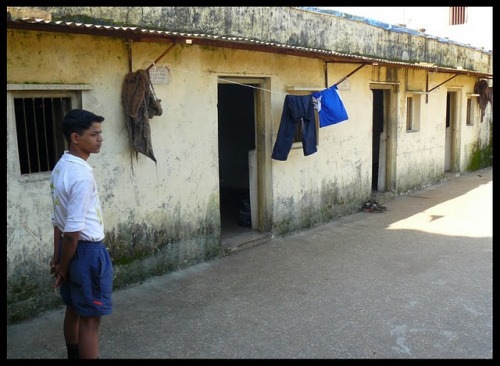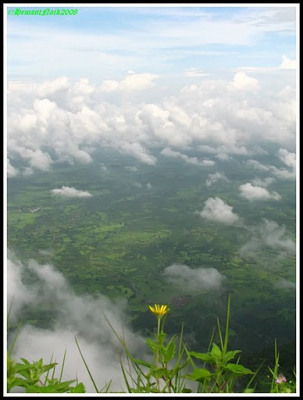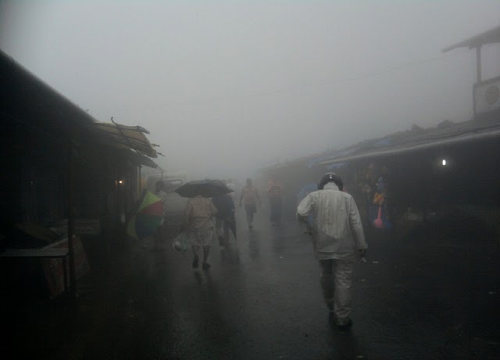Lodging for the night was easy to find. We walked into a dharmashala and negotiated a room for Rs. 150. Just an 8×10 feet room, tiled by rough cut, unpolished slabs of granite, a solitary window, a door and a sheet of rippled asbestos for roof. The courtyard outside was spacious and formed the center of this dharmashala with connected rooms on it’s periphery.

Dharamshala in Bhimashankar
The room came with just a coir rope strung on nails across the length of a wall, probably as a clothes line – that’s how we treated it in any case. Upon inquiring we received a large sheet of polyurethane foam (typically used to wrap cooling pipes in air conditioning installations) meant to be used as a more comfortable sleeping surface and I must confess, it didn’t disappoint the purpose. The sheet of foam tempted me to lie down flat on my back gazing out-of-focus at the clear blue sky, framed by the window.
No bathroom and toilet facilities anywhere meant that one had to revert to primitive practices. I was keen on taking a dip in the temple pond. We started trudging towards the temple. As surprised at how much I was able to reconcile the trail to the one in my memory from 15 years ago I was equally surprised at how much I could not reconnect to anything about the town itself. Many things had changed and as is the case with any commercially booming town in India, most of the changes were unappealing to the senses. An all pervading sense of faith in a town cradled in nature and inhabited by rustic locals was the lasting impression that I nursed. Now, the sense of commerce was the most overpowering one. Almost all structures along the solitary street running through this town was a business establishment. Since the town had just one street, all new structures mushroomed in close proximity to it and as a result a walk in any of the gullies (by-lanes) enveloped one in a palpable sense of claustrophobia.
The advent of satellite television made a quiet meal in this town almost impossible. If a cricket match was the unwelcome guest in one of the eating establishments, the high pitched background score of an evening drama series dripping with melodrama on a Marathi channel was unavoidable at another. Engaging a local in casual exchange of views and ideas on life and times that was once easy to come by with the mildest of prodding is also dying. Asphyxiated by the ever encroaching pop “culture” perhaps.
The temple pond was a disappointing sight. A layer of algae combined with flowers, garlands and other temple offerings successfully conspired against our taking a dip in it. Upon inquiring about another, possibly cleaner, pond we were told that this is the only one. That was followed by encouraging words to the effect that it’s quite common practice for people to take a dip in this one. I had to admit that the state of the pond must be much better compared to the state of Ganga but that still failed as a clinching argument in favour us taking the dip. We retraced our steps back to the dharamshala and inquired about any possible structure they may have for bathing. Luckily, the landlady pointed us to a solitary structure on top of a corner of the establishment. Water had to be carried in buckets to this structure over steps made of iron. The bathroom itself was nothing but a narrow room with gaps in the walls framed for a door and a window. The layer of fine dust on the floor combined with the fact that the door and window frames had no shutters made it clear to us why this was suggested to us as a terminal afterthought. First impressions cannot be trusted though because the window provided with the most captivating, unobstructed and sweeping view of the blooming valley below.

The valley below
All immediate urges were waylaid by this sight and it was a good while before I managed to wake myself from this spell and get to my tasks.
The landlady who managed the dharamshala informed us that dinner would be served for all at the temple for free. This is an annual Navratri tradition here. We could hear the raucous bhajans being sung by someone who had to be a chikna ghada (well-polished round bottom vessel) with criticisms. We had been hearing his bhajans (devotional songs) on the loudspeaker, in fact the whole town could hear him, since 4pm. It was 8pm now and he continued until 11pm with the same unflagging fervour. The bhajans were liberally interspersed with instructions being shouted to the volunteers helping out in organising the festivities. “Align the chairs properly”, “Serve this person, he’s been seated for a long time”. Gods must have felt confused on whether to oblige or to heed. I wondered how many would be annoyed at the abusive contorting of this devout and powerful (the loudspeaker was loud) medium. Like the enchanted mice of the pied piper fable I followed the sound to the temple and observed that this bothered nobody. That bothered me even more.
The food was sumptuous, served hot, seemed hygienic and tasted exactly as bland as a charitable dinner must taste. Limitless rice, daal and a sweet dish made of some other form of pulse. It was served on patravali (dried leaves entwined by slender stems) in the temple courtyard. It would be no exaggeration that the entire town showed up for this feast. The buzz in the village about the feast belied it’s simplicity though. One would guess from all the talk that the feast was indeed a “feast”. Nonetheless, the food hit all the right comforting spots and satisfied my final worldly care of the day.
By now the town was covered in heavy mist. It wasn’t chilly, just foggy and damp.

A stroll in the clouds
A walk around the town became even more adventurous when one could barely see beyond one’s feet. At the open ground where we had the lime juice earlier, a State Transport bus had halted for the night. The driver and the conductor were preparing their sleeping beds within the bus. There was nothing else for us to do but crash for the night.
The sun hadn’t risen when we departed from the dharamshala. After a quick visit to the temple and a stop over at the only open tea stall we began our descent. The thick foliage was sweating heavy mist from the previous night. It was noticeably cooler here than in the village. I was instantly soaked up to my knees from brushing against the undergrowth with it’s heavy dew settlement. The forest was distinctly cacophonous from the bird calls now than it was on our ascent. The streams that were barely a trickle yesterday were more sprightly today, glinting against the golden rays. It was as pleasant a walk in the hills as it could be and we took every opportunity to admire sunshine creeping across the valley, illuminating the dew covered landscape. We encountered a couple of groups of hiking enthusiasts on their ascent as well as a cowherd carrying his produce of milk to the village. Yesterday’s tea shack wasn’t open today yet. We finished the descent comfortably, with time to spare. A small pond under a bridge with stream water running through it was far too inviting to ignore. Before I knew it I was lying in the crisp cool water, the gentle morning sun rays kissing my skin above water and tadpoles doing the same underwater. It was a feeling like no other I had experienced and time, body and mind, all stood still.
I couldn’t tell how much time had passed this way but the sun was no longer gentle. The valley was baking under it’s shrill rays. The rising steam didn’t help either and it was a sign for us to keep moving. We reached the village and waited patiently in the tuk-tuk until it was filled to full capacity before it could depart. It was a 20 minute ride to Kashele. We were waiting for our bus as well as eying for refreshments. A beer shop caught my eye and luckily they had a can that was perfectly chilled. Gulping it down in a shade with the brutal Sahyadri heat seeping through my skin was a perfect spot to end this journey.
Reaching home from here was as monotonous as a commute.
27th September, 2009. Mumbai.
